The Electric Outboard Engines Market is estimated to be valued at USD 966.5 million in 2025 and is projected to reach USD 1747.2 million by 2035, registering a compound annual growth rate (CAGR) of 6.1% over the forecast period.
The 5-year growth block analysis of the electric outboard engines market suggests a steady rise in market value, from USD 966.5 million in 2025 to USD 1,299.5 million by 2030, reflecting a compound annual growth rate (CAGR) of 6.1%. Over this period, the market is expected to see consistent growth, with values rising from USD 966.5 million in 2025 to USD 1,025.4 million in 2026, reaching USD 1,088.0 million by 2027. This gradual increase indicates a growing demand for electric outboard engines, driven by shifting preferences for cleaner, more efficient propulsion systems in the boating industry. As the market matures, a shift toward electric power in marine vessels is becoming increasingly evident.
The continued rise in consumer awareness and regulatory pressures on traditional fuel-based engines are anticipated to further accelerate the growth of electric outboard engines. By 2030, the market is likely to witness a strong push, with values reaching USD 1,299.5 million. This growth is expected to be fueled by the increasing adoption of electric propulsion systems, driven by cost savings in fuel and maintenance, as well as growing demand from recreational boaters and commercial marine operators. With the market poised for expansion, electric outboard engines are expected to play a key role in reshaping the future of boating, offering a cleaner and more cost-effective alternative to traditional outboard motors.

| Metric | Value |
|---|---|
| Electric Outboard Engines Market Estimated Value in (2025 E) | USD million |
| Electric Outboard Engines Market Forecast Value in (2035 F) | USD 1747.2 million |
| Forecast CAGR (2025 to 2035) | 6.1% |
The electric outboard engines market is experiencing accelerated growth, supported by the rising demand for environmentally sustainable propulsion solutions in marine transportation. Increasing regulatory pressure to reduce carbon emissions, coupled with advancements in battery technology, is enhancing the performance, range, and operational efficiency of electric propulsion systems. The growing shift toward clean energy in recreational boating, commercial operations, and water-based tourism is expanding adoption across multiple segments.
Cost reductions in lithium-ion and solid-state battery systems, alongside improvements in charging infrastructure, are making electric outboard engines more accessible to both individual and fleet operators. Enhanced torque delivery, reduced maintenance requirements, and quieter operation compared to internal combustion alternatives are strengthening market appeal.
Global marine safety and environmental compliance standards are further encouraging vessel owners to transition toward electric solutions With innovations in lightweight materials, digital integration, and fast-charging capabilities, the market is positioned for sustained expansion, catering to both leisure and professional marine applications in line with evolving consumer preferences and environmental policies.
The electric outboard engines market is segmented by power range, speed range, application, distribution channel, and geographic regions. By power range, electric outboard engines market is divided into 25 – 50 kW, Below 25 kW, and 50 – 150 kW. In terms of speed range, electric outboard engines market is classified into 5-10 mph, Below 5 mph, 10-15 mph, and Above 15 mph. Based on application, electric outboard engines market is segmented into Recreational, Commercial, and Military. By distribution channel, electric outboard engines market is segmented into Direct Sales and Indirect Sales. Regionally, the electric outboard engines industry is classified into North America, Latin America, Western Europe, Eastern Europe, Balkan & Baltic Countries, Russia & Belarus, Central Asia, East Asia, South Asia & Pacific, and the Middle East & Africa.
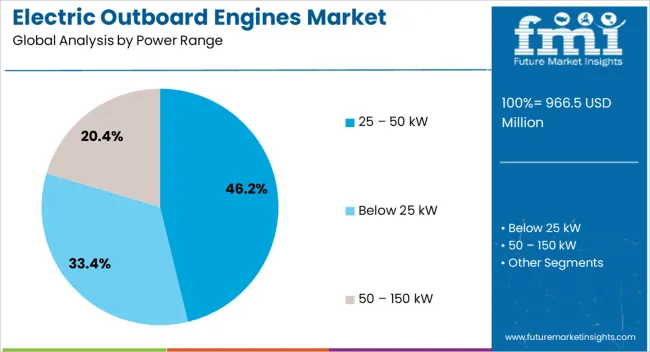
The 25 to 50 kW power range segment is projected to hold 46.2% of the electric outboard engines market revenue share in 2025, making it the leading power category. This leadership is being driven by the segment’s ability to provide an optimal balance between power output, efficiency, and versatility for a wide variety of marine applications. Engines within this range deliver sufficient propulsion for medium-sized boats while maintaining energy efficiency and extended battery life.
The segment benefits from growing adoption in both recreational and light commercial vessels, where performance reliability and reduced environmental impact are key priorities. Continuous advancements in battery capacity, motor efficiency, and thermal management systems are enabling engines in this category to operate for longer durations without compromising output.
The capability to pair with modular battery configurations allows for scalable performance depending on operational needs With increasing demand for electric propulsion in both inland waterways and coastal zones, the 25 to 50 kW range is expected to retain its dominant position due to its adaptability and strong performance-to-cost ratio.
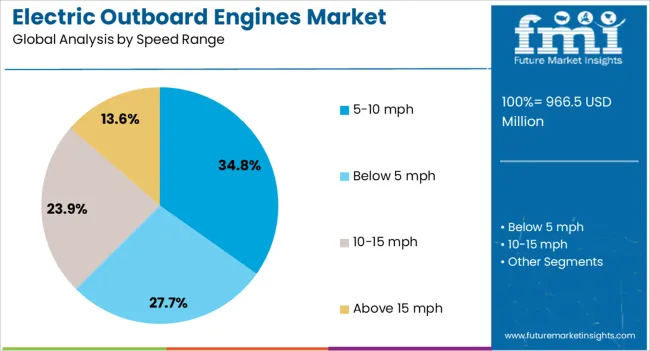
The 5 to 10 mph speed range segment is anticipated to account for 34.8% of the electric outboard engines market revenue share in 2025, establishing itself as the largest speed category. This dominance is being reinforced by its suitability for leisure boating, fishing, and eco-tourism activities where moderate speeds ensure safety, stability, and energy efficiency. Engines in this range are highly compatible with battery optimization strategies, extending operational time between charges while minimizing strain on power systems.
The segment is gaining traction among both individual boat owners and rental operators seeking reliable and low-maintenance propulsion solutions for calm waters and short to medium-distance travel. Increased demand for vessels that operate quietly to enhance user experience and comply with noise regulations in protected waters is also contributing to growth.
Technological improvements in motor design and power management software are further enhancing performance consistency With expanding adoption in recreational and light commercial sectors, the 5 to 10 mph range is expected to maintain its leadership through its alignment with operational efficiency and user comfort requirements.
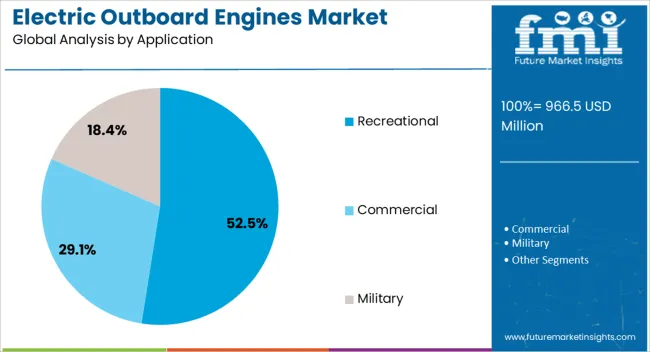
The recreational segment is expected to represent 52.5% of the electric outboard engines market revenue share in 2025, positioning it as the leading application area. Its dominance is being driven by the increasing popularity of leisure boating, water sports, and personal watercraft ownership, supported by growing disposable incomes and expanding marina infrastructure.
Electric outboard engines are being increasingly chosen for recreational use due to their low noise levels, minimal maintenance needs, and eco-friendly operation, which align with consumer demand for sustainable leisure activities. Government incentives and environmental regulations are encouraging the adoption of electric propulsion in lakes, rivers, and coastal areas, particularly in regions with restrictions on combustion engines.
The segment is also benefiting from technological advancements that enhance acceleration, range, and overall reliability without compromising user experience As the boating community becomes more environmentally conscious, the shift toward electric recreational vessels is expected to accelerate, ensuring continued dominance of this segment in the global market over the forecast period.
The electric outboard engines market is gaining momentum, driven by rising demand for sustainable marine solutions and the ongoing push for greener technologies. Opportunities lie in advancements in battery technology and motor efficiency, which are enhancing the performance and range of electric engines. While challenges related to battery life and charging infrastructure persist, the trend toward electrification in both recreational and commercial boating is strong. The market outlook remains positive, with continued innovation and regulatory support paving the way for growth.
The electric outboard engines market is growing due to increasing demand for environmentally friendly alternatives in the marine industry. As consumers and regulatory bodies push for reduced emissions and sustainability, electric outboard engines are gaining popularity, particularly among recreational boaters and commercial fleets looking to minimize their environmental footprint. The market is driven by the shift toward cleaner technologies and more sustainable boating practices, with electric engines offering zero-emissions operations, quiet performance, and lower maintenance costs.
The electric outboard engines market is ripe with opportunities due to ongoing advancements in battery and motor technologies. Enhanced energy density in lithium-ion batteries and improvements in motor efficiency are extending the range and performance of electric engines, making them more competitive against traditional gas-powered engines. As manufacturers focus on reducing charging times, improving battery longevity, and optimizing energy use, these innovations are likely to drive market growth. The push toward electrification in the marine sector will continue to create opportunities for companies in this space.
Electrification in both recreational and commercial boating is becoming a significant trend. With recreational boat owners prioritizing green alternatives and commercial fleets focusing on cost savings and emissions reduction, electric outboard engines are becoming the preferred choice. Technological improvements have made these engines more affordable, while government incentives for electric vehicles and low-carbon technologies are encouraging adoption. The trend toward eco-friendly and efficient marine solutions is expected to expand as consumer awareness of sustainability in boating grows.
One of the primary challenges facing the electric outboard engine market is the limitation of battery life and charging infrastructure. While electric engines offer many advantages, their range is often limited compared to traditional fuel-powered engines, which can affect long-distance boating. Additionally, the availability of charging stations remains limited, particularly in remote or less-developed regions. Addressing these challenges by improving battery technology, expanding charging networks, and enhancing energy management systems will be crucial to the widespread adoption of electric outboard engines.
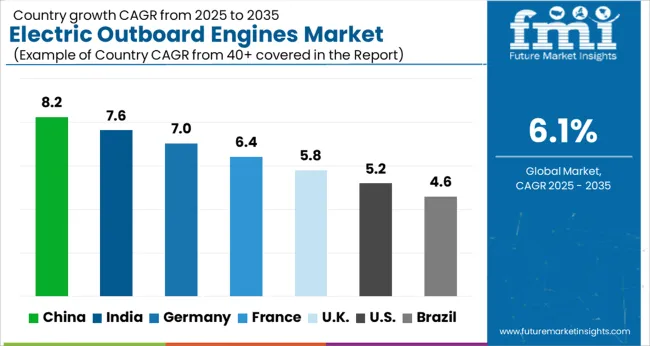
| Country | CAGR |
|---|---|
| China | 8.2% |
| India | 7.6% |
| Germany | 7.0% |
| France | 6.4% |
| UK | 5.8% |
| USA | 5.2% |
| Brazil | 4.6% |
The global electric outboard engines market is projected to grow at a 6.1% CAGR from 2025 to 2035. China leads with a growth rate of 8.2%, followed by India at 7.6% and France at 6.4%. The United Kingdom records a growth rate of 5.8%, while the United States shows a growth rate of 5.2%. The varying growth rates reflect the adoption of sustainable technologies in the marine sector, driven by increasing demand for eco-friendly recreational vehicles. Emerging markets like China and India are experiencing higher growth due to increasing environmental awareness, urbanization, and tourism activities, while more mature markets like the USA and the UK see steady growth due to strong government support for clean technologies and the shift towards sustainable boating solutions. This report includes insights on 40+ countries; the top markets are shown here for reference.
The electric outboard engines market in China is projected to grow at a CAGR of 8.2%. China’s rapid urbanization and growing demand for eco-friendly alternatives in the boating and recreational vehicle sector are key factors driving market growth. The Chinese government’s support for green technologies and the push towards reducing emissions is contributing significantly to the adoption of electric outboard engines. Additionally, the country’s extensive coastline and significant maritime activities create a large demand for marine equipment. As the boating industry shifts towards cleaner, more sustainable solutions, China is expected to maintain its position as a leader in the electric outboard engines market.
The electric outboard engines market in India is projected to grow at a CAGR of 7.6%. India’s expanding interest in recreational boating, coupled with increasing environmental awareness, is driving the adoption of electric outboard engines. The country’s large coastline and growing interest in marine tourism and water sports are contributing to the market’s growth. Additionally, India is increasingly focusing on sustainable technologies and renewable energy solutions, which is encouraging the shift to electric propulsion systems for boats. The market is further supported by government policies aimed at promoting electric vehicles and reducing emissions in the marine industry.

The electric outboard engines market in France is projected to grow at a CAGR of 6.4%. France’s commitment to environmental sustainability and the increasing demand for eco-friendly recreational vehicles are driving the adoption of electric outboard engines. The country’s popularity in boating and marine tourism, particularly in coastal and river-based regions, is contributing to the demand for electric outboard motors. Moreover, France’s government initiatives to reduce carbon emissions and promote green technologies are expected to continue fueling market growth. With a focus on clean and efficient boating solutions, France is poised for steady growth in this market.
The electric outboard engines market in the United Kingdom is projected to grow at a CAGR of 5.8%. The UK’s increasing focus on sustainability, particularly in reducing carbon emissions in the marine sector, is driving the demand for electric outboard motors. The country’s growing recreational boating sector, combined with rising consumer demand for cleaner, quieter propulsion options, is further pushing market growth. Moreover, the UK government’s efforts to promote the adoption of electric vehicles across various sectors, including marine transport, are expected to contribute to the continued expansion of the electric outboard engines market.

The electric outboard engines market in the United States is projected to grow at a CAGR of 5.2%. The USA is seeing increasing demand for electric propulsion systems, especially in the recreational boating and fishing industries. The country’s growing environmental consciousness and the rising trend towards sustainable boating solutions are encouraging the adoption of electric outboard motors. Government initiatives to support green technologies and reduce emissions in the transportation sector are contributing to the expansion of the market. With the increase in eco-tourism and recreational activities on lakes and rivers, the demand for electric outboard engines is expected to continue rising.
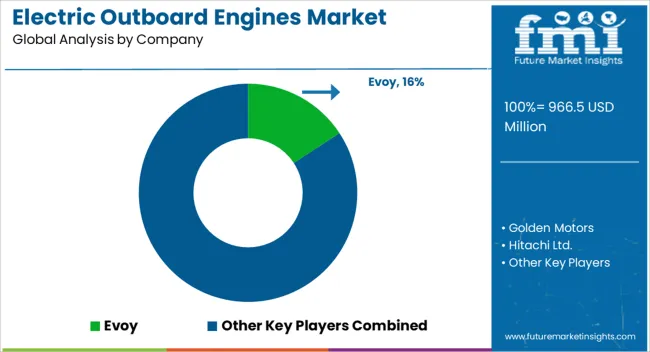
Leading companies in the electric outboard engines market, such as Evoy, Golden Motors, and Hitachi Ltd., are at the forefront of revolutionizing the marine industry with sustainable and high-performance electric propulsion systems. These players focus on delivering environmentally friendly alternatives to traditional fuel-powered outboard motors by offering solutions that ensure low maintenance, higher energy efficiency, and reduced emissions. Evoy, with its powerful electric outboard engines, is targeting high-performance boat enthusiasts, while Golden Motors and Hitachi are expanding their portfolios to provide a variety of electric propulsion systems for recreational and commercial vessels. The push for greener solutions and technological advancements in battery efficiency has placed these companies in a strong position to lead the market.
Companies like Minn Kota, Mitsubishi Electric Corporation, and Torqeedo GmbH are capitalizing on their expertise in the electric mobility sector to offer innovative outboard engines that cater to the growing demand for eco-friendly boating solutions. Minn Kota focuses on creating user-friendly systems with long-lasting battery life, making them popular in both the recreational and fishing boat markets. Torqeedo, on the other hand, is known for its advanced electric motor technologies and integration with solar-powered systems. Regional players like Pure Watercraft and Parsun Power are also gaining traction by offering cost-effective electric outboard engines designed to meet the needs of eco-conscious boat owners. As demand for sustainable water transportation grows, the future of the market will depend on continuous innovations in battery technology, power efficiency, and affordability.
| Item | Value |
|---|---|
| Quantitative Units | USD Million |
| Power Range | 25 – 50 kW, Below 25 kW, and 50 – 150 kW |
| Speed Range | 5-10 mph, Below 5 mph, 10-15 mph, and Above 15 mph |
| Application | Recreational, Commercial, and Military |
| Distribution Channel | Direct Sales and Indirect Sales |
| Regions Covered | North America, Europe, Asia-Pacific, Latin America, Middle East & Africa |
| Country Covered | United States, Canada, Germany, France, United Kingdom, China, Japan, India, Brazil, South Africa |
| Key Companies Profiled | Evoy, Golden Motors, Hitachi Ltd., Minn Kota, Mitsubishi Electric Corporation, Parsun Power, Pure Watercraft, and Torqeedo GmbH |
| Additional Attributes | Dollar sales by engine type (brushless DC, permanent magnet) and power capacity (low, medium, high) are key metrics. Trends include increasing demand for eco-friendly, quiet propulsion systems in recreational boating and marine industries. Regional adoption, advancements in battery technology, and government regulations on emissions are driving market growth. |
The global electric outboard engines market is estimated to be valued at USD 966.5 million in 2025.
The market size for the electric outboard engines market is projected to reach USD 1,747.2 million by 2035.
The electric outboard engines market is expected to grow at a 6.1% CAGR between 2025 and 2035.
The key product types in electric outboard engines market are 25 – 50 kw, below 25 kw and 50 – 150 kw.
In terms of speed range, 5-10 mph segment to command 34.8% share in the electric outboard engines market in 2025.






Full Research Suite comprises of:
Market outlook & trends analysis
Interviews & case studies
Strategic recommendations
Vendor profiles & capabilities analysis
5-year forecasts
8 regions and 60+ country-level data splits
Market segment data splits
12 months of continuous data updates
DELIVERED AS:
PDF EXCEL ONLINE
Electric Vehicle Sensor Market Forecast and Outlook 2025 to 2035
Electric Vehicle Motor Market Forecast and Outlook 2025 to 2035
Electric Off-Road ATVs & UTVs Market Size and Share Forecast Outlook 2025 to 2035
Electric Blind Rivet Gun Market Size and Share Forecast Outlook 2025 to 2035
Electric Fireplace Market Size and Share Forecast Outlook 2025 to 2035
Electric Glider Market Size and Share Forecast Outlook 2025 to 2035
Electric Vehicle Battery Conditioners Market Size and Share Forecast Outlook 2025 to 2035
Electric Power Steering Motors Market Size and Share Forecast Outlook 2025 to 2035
Electric Motor Market Size and Share Forecast Outlook 2025 to 2035
Electric Gripper Market Size and Share Forecast Outlook 2025 to 2035
Electric Boat Market Size and Share Forecast Outlook 2025 to 2035
Electric Bicycle Market Size and Share Forecast Outlook 2025 to 2035
Electric Vehicle Transmission Market Size and Share Forecast Outlook 2025 to 2035
Electrical Enclosure Market Size and Share Forecast Outlook 2025 to 2035
Electrical Sub Panels Market Size and Share Forecast Outlook 2025 to 2035
Electric Cargo Bike Market Size and Share Forecast Outlook 2025 to 2035
Electrical Testing Services Market Size and Share Forecast Outlook 2025 to 2035
Electric Sub-meter Market Size and Share Forecast Outlook 2025 to 2035
Electric Light Commercial Vehicle Market Size and Share Forecast Outlook 2025 to 2035
Electric Vehicle Fluid Market Size and Share Forecast Outlook 2025 to 2035

Thank you!
You will receive an email from our Business Development Manager. Please be sure to check your SPAM/JUNK folder too.
Chat With
MaRIA